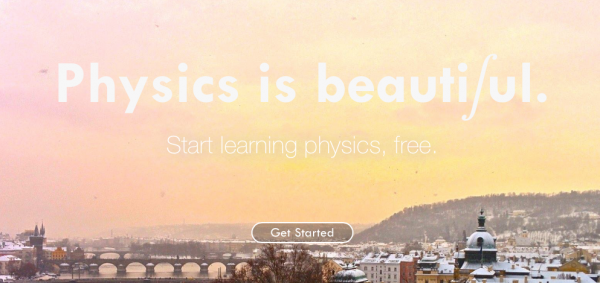
Physics is Beautiful App Released
The Ohio State University Physics PhD candidate Nic Scozzaro had a big idea: make physics instruction fun, fast and free for audiences around the globe. Along with his physicist partners Hiran Wijesinghe and Michael Darcy, Scozzaro has spent the past two years creating and testing an app that promises to do just that. A Tech Hub grant recipient for 2016, Physics is Beautiful is a web app that provides free physics instruction through engaging games and a completely online platform.
As a physics student and instructor at many levels throughout his academic career, Nic Scozzaro has seen the gamut of instructional methods and believes the learning experience can be made dramatically more efficient.
“It frustrates me to see how many people are driven away from pursuing physics because it has a stigma for being really hard and boring,” Scozzaro said of the current state of physics instruction. “My dream is for people to be able to learn not just physics, but all technical subjects like math, computer programming, chemistry and biology, in a short period of time without needing to step foot in a classroom.”
Scozzaro found the courses that were especially challenging lacked a meaningful way to apply hands-on learning to course material. He thought about new approaches to education that he found compelling, like Duolingo: a language learning app that uses a free, mobile, gamified platform; and CodeAcademy: a free app that teaches computer programming; and wondered how he could take the successes of those platforms and apply that to online physics instruction.
“I believe that gamification is the secret sauce to making online education work,” Scozzaro said. “Our goal is for our app to be addicting like a game, but to teach the standard physics curriculum that is taught in school. We’re building our content to identically follow standard physics curriculum so that it can easily be used by teachers and students at any level.”
In January 2016, Scozzaro began creating the app to show proof of concept. He soon brought on two other physics PhD candidates, Darcy and Wijesinghe, who helped to write lessons and program the app to follow entry level physics curriculum. The Center of Emergent Materials provided administrative support that led to a number of “sprint” sessions where around 10 OSU physics PhD students met to quickly create content for the app. After months of work they had an opportunity to test the app that summer with a physics 1200 course at Ohio State. The professor agreed to use the platform as homework and by the end of the semester 90 percent of students in the course had completed the lessons, on average showing a 50% increase in correct answers on between a pre-test and post-test.
One of the aspects of the current physics education system that Scozzaro cites as particularly problematic is that students can find the solutions to most homework assignments online, a shortcut that can reduce how much students learn from their homework. The new app aims to solve this problem by making wrong answers part of the learning process, instead of being penalized.
“I liked that you could actually learn from what you got wrong, instead of just getting 10 tries to attempt to find the correct answer” said Sarah Eddy, a student in the summer course. “Plus, I didn't have to try to Google search any answers like I do on Mastering Physics.”
They took feedback from students and data from course participation to retool and improve the app.
“We continued to work on the app but we had lot of technical debt – that is, the app was really hacked together and it was hard to add new features and make it a more scalable and robust product,” Scozzaro said.
Hiran and Scozzaro applied for the Tech Hub grant and won $2000 which they used to hire Damian Hites, a software developer based in New York, to retool the app in a python web framework called Django.
Flash forward to today. Scozzaro and Wijesinghe have created an app that covers a majority of entry level physics curriculum including vectors, motion diagrams, kinematics and more. With a finessed product complete they are excited to release their work to the public.
“We passionately believe that it's possible to build a product that teaches physics drastically more efficiently than the current school system, and we believe that our initial web app is the first step in that direction,” Scozzaro said. “The demand for the technical skills learned in physics is only growing. There is a strong market for a product that teaches physics better, faster, and in a more enjoyable way. Duolingo has pioneered a gamified, structured approach to education that has been highly successful, and we believe that similar innovation can revamp the face of physics education”.
Revamping the face of physics education: no small feat. Interested in checking out their work? The Physics is Beautiful App is now open to anyone interested in learning more about physics.
Are you ready to turn your idea into reality? Apply for a Tech Hub fall 2017 grant.

